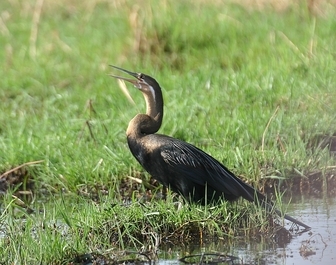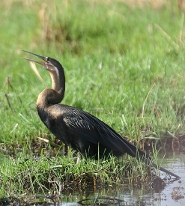African Darter
The African Darter , sometimes called the Snakebird, is a water bird of tropical sub-Saharan Africa.

Original source: Anhinga rufa Daudin, 1802Deutsch: afrikanischer Schlangenhalsvogel im Chobe N.P. (Botswana)English: african Darter in Chobe N.P. (Botswana)photo self taken by Susann Eurich (Kilara), November 2005
Permission: GNU Free Documentation License
African Darter - The Riverside Snakebird
 The African Darter (Anhinga rufa), also known as the Snakebird, is an animal unique to sub-Saharan Africa. It is known for its very long neck and its unique swimming style. The African Darter gets the nickname "Snakebird" because it swims similar to the way a snake slithers. Its head is above water while swimming, which is a different style from many birds worldwide. The African Darter is typically found in tropical wetlands, and they spend a lot of time sitting beside bodies of water, particularly in areas where mangroves are prominent. The African Darter is fond of shallow, still waters and usually swims with its head above water. Unlike many birds, the feathers of the African Darter are not waterproof, and the bird must dry its feathers before taking flight. For the most part, these birds lead a sedentary lifestyle. These birds are fairly large, with a body size reaching close to 80 centimeters and weight close to 1400 grams. In imperial units, this is equal to roughly 30 inches or three pounds.
The African Darter (Anhinga rufa), also known as the Snakebird, is an animal unique to sub-Saharan Africa. It is known for its very long neck and its unique swimming style. The African Darter gets the nickname "Snakebird" because it swims similar to the way a snake slithers. Its head is above water while swimming, which is a different style from many birds worldwide. The African Darter is typically found in tropical wetlands, and they spend a lot of time sitting beside bodies of water, particularly in areas where mangroves are prominent. The African Darter is fond of shallow, still waters and usually swims with its head above water. Unlike many birds, the feathers of the African Darter are not waterproof, and the bird must dry its feathers before taking flight. For the most part, these birds lead a sedentary lifestyle. These birds are fairly large, with a body size reaching close to 80 centimeters and weight close to 1400 grams. In imperial units, this is equal to roughly 30 inches or three pounds.
African Darters typically live in groups of ten to fifty birds at a time, sometimes with colonies reaching one hundred birds in size. Breeding can be a seasonal affair, but birds can mate at any time during the year. The breeding grounds is normally on a nest platform constructed by the birds. The platforms can be found in trees or on islands near the water. Usually, birds lay nests of around three to six eggs at a time. After breeding, some birds may go through a flightless period of time, although this is not universal within the species.
Since the African Darter spends a lot of time in and around shallow bodies of water, its diet is composed primarily of amphibious animals. They mainly eat fish, frogs, crustaceans, or molluscs. These birds are able to eat fish and other foods from either saline or freshwater environments.
In some areas, the population of the African Darter has declined in recent years. This is due to pollution and destruction of the environment. It also has natural predators, including the tawny eagle, the African fish-eagle, and the harrier-hawk. However, these threats are not so great that the species is becoming endangered. The African Darter population is very widespread and numerous, and for the moment it is not an endangered species.
Picture of the African darter by Susann Eurich in Chobe N.P. (Botswana), licensed under GFDL
The African Darter is classified as Least Concern. Does not qualify for a more at risk category. Widespread and abundant taxa are included in this category.

Family : Anhingidae
Genus : Anhinga
Species : rufa
Authority : (Daudin, 1802)
